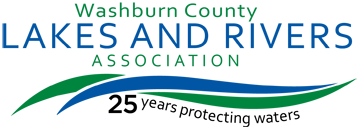Washburn County is blessed with many high quality lakes. Unfortunately, this is not true for some parts of Wisconsin. So what makes Washburn County lakes so attractive to those who enjoy time in and on them? What have landowners, lake associations, and government agencies done to preserve and enhance the quality of our public waters? There are a lot of actions to be sure, but one practice that helps is the amount of naturally vegetated shorelines along our lakes. Many lakeshore owners have left their shorelines natural or are taking small steps to restore native plants with the help of governmental agencies. Join your neighbors in protecting your lake.
Does shoreline vegetation really matter? Yes. The roots of native plants grow deeper and contribute to lake protection by reducing wave action and slowing water hitting or running down the bank and causing erosion. Native plants provide shade, food, cover, and nesting sites for fish, frogs, turtles, and other wildlife that live in or near the water. A vegetated area also filters pollutants such as fertilizers, pesticides, and pet waste washing off the land that contributes to algae blooms. Did you know one goose produces fifteen pounds of droppings per week? Geese prefer mowed lawns, so natural vegetation prevents them from being a nuisance.
An effective shoreline buffer has layers of vegetation including trees, shrubs, and wildflowers, ferns, grasses and sedges. The simplest way to achieve those layers is to stop mowing and let the native seedbed grow. Homeowners often create small paths and open areas to view the lake. Birdhouses and bird feeders add interest too. Keeping fallen trees and other woody debris along the water’s edge and in the water creates habitat for many different critters. For more information and assistance on protecting your shoreline, check out the sources listed below:
The Washburn County Land and Water Conservation Department has funding available for technical assistance to help you restore your shoreline to a native setting and/or help with an on-going erosion problem. Depending on the situation, up to 70% of costs can be reimbursed to the landowner. For more information, call 715-468-4654 or email landwtr@co.washburn.wi.us. A brochure on the program can be found on their website.
The Wisconsin Department of Natural Resources recently launched Healthy Lakes – a statewide initiative that includes web-based technical assistance and possible grant funding for relatively simple projects to improve water quality and habitat along lakeshores. There are five projects to choose from, depending on the site’s needs and landowner’s goals – whether replacing woody habitat in the water, restoring native plants, or slowing runoff and getting it to soak into the ground. Eligible sponsors like qualified lake associations, lake districts, towns, and the county can apply for grant funding on behalf of individual property owners. For more information, check out healthylakeswi.com or contact DNR Lake Biologist Pamela Toshner at 715-635-4073 or pamela.toshner@wi.gov.
Lake associations often provide information and implement projects that help protect and enhance the quality of our local lakes. WCLRA members are willing to help anyone interested in forming a lake association.
Article submitted by Lisa Burns, Washburn County Land and Water Conservation Department; Pamela Toshner, Wisconsin Department of Natural Resources; and Charlotte Shover, Washburn County Lakes and Rivers Association.







